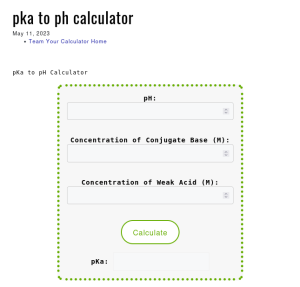pka to ph calculator
pKa to pH Calculator
What is pka to ph calculator?
The pKa to pH calculator is a useful tool that helps in calculating the pKa value from pH and the concentrations of a weak acid and its conjugate base. It is used in various fields, including chemistry, biochemistry, and pharmacology, to understand the acid-base equilibria of solutions. In this article, we will discuss the formula used in the pKa to pH calculator, its application, history, and some frequently asked questions.
Formula used in pKa to pH calculator :
The pKa to pH calculator is based on the Henderson-Hasselbalch equation, which is defined as follows:
pKa = pH – log10([conjugate base]/[weak acid])
Where pH is the logarithmic measure of the hydrogen ion concentration in a solution, [conjugate base] is the concentration of the conjugate base, and [weak acid] is the concentration of the weak acid.
Example: Suppose we want to find the pKa value of a weak acid whose pH is 3.5, and its concentrations of conjugate base and weak acid are 0.1M and 0.01M, respectively. Using the above formula, we can calculate the pKa value as follows:
pKa = 3.5 – log10(0.1/0.01) = 3.5 – log10(10) = 3.5 – 1 = 2.5
Therefore, the pKa value of the given weak acid is 2.5.
Brief History:
The concept of acid-base equilibria dates back to the 19th century when chemists first started investigating the properties of acids and bases. In 1908, the Danish biochemist Christian Bohr proposed a mathematical formula to describe the relationship between the pH and the dissociation constant of weak acids, which is now known as the Henderson-Hasselbalch equation. Since then, this equation has been widely used in various fields to understand the acid-base equilibria of solutions.
Application:
The pKa to pH calculator is widely used in various fields, including chemistry, biochemistry, and pharmacology. In chemistry, it is used to determine the strength of acids and bases and to calculate the pH of buffer solutions. In biochemistry, it is used to understand the behavior of enzymes, proteins, and other biomolecules in solution. In pharmacology, it is used to study the behavior of drugs in solution and to optimize drug design.
FAQs:
- What is pKa? pKa is the dissociation constant of a weak acid, which is a measure of its tendency to donate a proton to a solvent.
- What is the Henderson-Hasselbalch equation? The Henderson-Hasselbalch equation is a mathematical formula that describes the relationship between the pH and the dissociation constant of a weak acid.
- What is the significance of pKa in drug design? The pKa value of a drug can affect its solubility, bioavailability, and efficacy. Therefore, it is an important parameter to consider in drug design.
Conclusion: The pKa to pH calculator is a useful tool that helps in calculating the pKa value from pH and the concentrations of a weak acid and its conjugate base. It is based on the Henderson-Hasselbalch equation and is widely used in various fields, including chemistry, biochemistry, and pharmacology. The pKa value is an important parameter to consider in drug design, as it can affect the solubility, bioavailability, and efficacy of a drug.

More Calculator:
” width=”20″ height=”20″>
